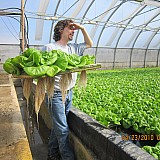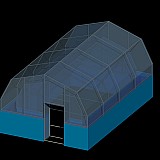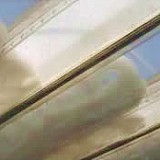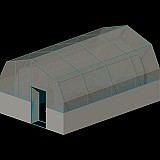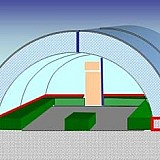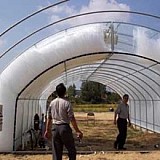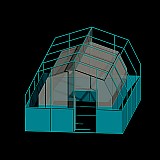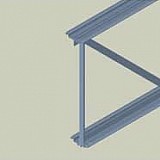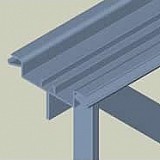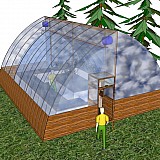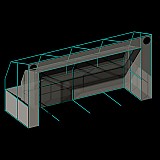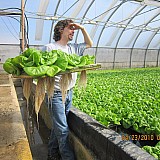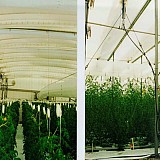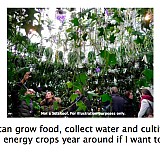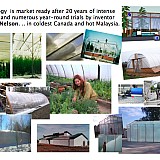About Sola Roof
The information below is an overview of our mission, history and current status. More details about past and ongoing milestones in our progress and stories by the people breaking our pathway to sustainable living will be contributed at our Pioneers page.
Some images to feed the imagination
(Click on the image to view. Clik on the right to go forward, and left to go back.) Slide01.png Δ
Problem Identification
What serious problem or challenge with broad significance does your use of technology address?
"Between 2000 and 2030, the International Energy Agency (IEA) projects that coal generation will double. The projected new plants would commit the planet to total carbon dioxide emissions of some 500 billion metric tons over their lifetime, which is roughly half the total emissions from all fossil fuel consumed worldwide during the past 250 years." At the same time the economic growth of China (with recent year over year export growth of about 30%) and other regions that are rapidly expanding (as compared to the USA) signals the vast scale of this issue as a global problem. Simultaneously we are now living during through a time of Peak Oil and the era we are entering will be one of declining supply of oil and increasing cost of non renewable resources. This brings us to the cusp of the problem: how to bring about a sustainable and prosperous life for all people that will not threaten us with Global Warming disasters brought on by costly runaway growth in energy supply and consumption.
Explain your context and the existing conditions that you are trying to improve or rectify.
Dr. Romm's testimony (cited above) is given in relation to the possible role of electric vehicle transport as a technology to mitigate the Global Warming problem, but sadly the committee's conclusion is that these technologies cannot achieve any significant result in the foreseeable future that would slow, let alone reverse, the negative trends. However, Ed Mazria, Architect, has produced an analysis that clearly proves that buildings, as compared to transportation, have at least twice the potential to affect the reversal of these negative trends. This technological potential is shown graphically:
Further, Christopher Alexander in his paper ORIGINS OF PATTERN THEORY finds that a "grass roots" implementation of a new pattern of living structures would provide the mechanism for a realistic plan to make a global paradigm shift to sustainable living. The construction (and renewal) of buildings in the initial three decades of the new millennium will create more built environment that has existed up to that time. The dilemma is that "experts" cannot be the channel for such a vast work and therefore the methods of construction of living structures must become accessible to everyone.
This is the reason that the Sola Roof solution for living structures is not only about technology but requires building a Community of enthusiasts all around the world who can champion the cause of living structures. First there are the pioneers in various regions, then a fledgling user community, and then a wide following of people who are empowered by our DIY (Do-It-Yourself) knowledge base to build Sola Roof technology into their homes and communities. At www.solaroof.org we are using powerful, new communication and collaboration tools to share experience and author the Sola Roof Wiki.
Description of Technology Application
What technology is being used?
Sola Roof technology is our primary solution for building the required living structures . This technology is formed around a core of inventions by Richard Nelson; his expired patents, now dedicated under a Creative Commons Public License, are a sound foundation for the elaboration of an Open Source system of construction. Sola Roof is a new pattern for building design, which we refer to as an Ecomimicry Architecture that is based on a light-weight, transparent building envelope that uses new materials technology called Sola Fabric and this structural system is integrated with a controlled environment system that produces comfortable and productive living, working and recreational spaces within the Sola Roof structure.
The novel systems of Bubble Tech and Liquid Solar Tech are described in the Sola Roof Tech section of our Sola Roof Wiki website where there is also a Gallery showing many images and illustrations of completed projects. Our approach is low tech and is based upon the Blue Green paradigm of using Water Working (the Blue) and Plants + Algae (the green) within the building and at the roof level of the structure for the purpose of capturing and converting solar energy that enters the transparent building envelope. Simple, low-energy mechanical systems are integrated with complex ecological life support systems that produce a net gain in energy in the form of stored thermal cooling and heating energy, modulated "cool daylight" and production of plants for food, feed, fiber and biomass for production of biofuels and biotechnology products. Sola Roof buildings primarily use the powerful phytomechanisms of a living leaf canopy to transformation of solar energy by the processes of photosynthesis and transpiration.
Thus we make accessible and affordable a solar design that is based upon life science and biomimicry. Our roof level plant cultivation within a controlled environment growing space is a new approach to biomass production that could employ the roof areas of all buildings for a Biomass to Biofuel process; a solar technology process that we call Eco Dynamic, which, because it sequesters carbon dioxide in Bio Fuel is an excellent strategy for mitigation of Global Warming.
How is it being used?
Richard Nelson first used the technology for private experiments from the time of invention (about 1973) until about 1979-80 when the first patents were applied for. Then Nelson used the technology as a basis for his private R&D enterprise that was funded by private and government funding until about 1995. During this time many "commercial confidential" laboratory, field testing and demonstration scale projects were implemented, the largest being a 6,000 square foot greenhouse at McGill University in Montreal.
After the development work described above came a period of several years when Nelson advised on the construction of a few Sola Roof projects sponsored by private enterprise, including projects at a school, a university, a residence and a 12,000 square foot greenhouse near Calgary that was in full production of a commercial tomato crop for about 3 years. Again, this activity was largely confidential (not published) but did provide Nelson a wide base of experience and testing that prepared the way for wide spread use of the technology - however there was no clear indication of how the technology could be commercialized as a business venture.
At about 2001 Nelson was inspired by the success of the Open Source Software Community and the success with the Linux Operating System software and Wikipedia that has involved some 40,000 individuals who have contributed over the last several years to an "open" project that reveals all of the knowledge (the source code) developed to any user or developer. Even the commercial users of the Open Source software have access to the technology. I became convinced that this would be a perfect example to follow to bring Sola Roof technology to a Community of end-users, and among these would be found the core community of collaborative developers. The Community would also give birth to an open and cooperative network of businesses that would supply components and materials produced to the Open Source specifications that are published and constantly improved by our Community. This business environment supports the emergence of a Social Enterprise Network called SE Net where companies' criteria for success is to achieve a good or excellent Triple Bottom Line.
Who is responsible?
Since 2002 we have been establishing a global Sola Roof Community by operating our Yahoo Forum and the core group of developers and end-users now numbers about 900 individuals and extends to thousands of interested supporters. Among the DI Yers (Do-It-Yourselfers) are enthusiasts we call pioneers who are leading the way as Enterprise Members and we are developing simple patterns for Sola Roof DIY that a large number of people can duplicate. We are a community of individuals with a sincere interest in personal transformation of our own lives, to live without dependence on oil, central power and food grown thousands of miles from our table.
Sola Roof has been first applied to growing organic food and to collect and purify water. We have the goal of establishing a pattern of Eco Living where organic nutrients are recycled into growing our food and where we would live in solar homes that are self reliant for heating, cooling and energy. This is possible because we now have the technology required into an open and collaborative environment where a multitude of talented and motivated persons, who have between them an abundance of skills and intelligence to apply to achieving our goal through working together. Our members are taking collective responsibility to develop and implement the solutions to the problems that businesses, governments and institutions of all kinds have failed to deliver.
In the light of these recognized obstacles, it is appropriate that our Community will adopt the Open Space Technology for self organization that is managed by our collective intelligence. We also bring heart, spirit and compassion to the task of self organizing which is a reflection of a natural capacity for synergy that is found in ecologies in Creation itself.
Who is benefiting?
Sola Roof Tech is FREE and openly accessible for non-commercial use and benefit of all people. Home owners can implement the technology to build self reliant garden homes and solar greenhouses that provide food, water and energy from the ambient environment including exploiting solar, earth and water resources on a sustainable basis. Commercial users and supply of Sola Roof branded products have an obligation to register their use under our Creative Commons Public License, which requires 1)Attribution, 2)Share-Alike and, 3) Pay It Forward of 1% of related revenue (to the Sola Roof Foundation).
Communities will benefit from the savings achieved in reduction of consumption and the production of distributed wealth. Every locality will be more self-sufficient for food and water security even in the face of Climate Change and toxic environment threats that are now unavoidable. Our internet community encourages people to take action to help other people, including our Pay It Forward initiative to bridge the gaps that exist between communities, assist the homeless and refugees that are dislocated by natural or man made disasters.
If applied universally to roof construction the technology will provide society will the benefit of the mitigation of CO 2 accumulation in the global atmosphere, which will alleviate the seriousness and frequency of weather related disasters. Urban locations will find a reduction in the Heat Island Effect? which is capable of magnifying the problems of Global Warming in our cities. Rural areas will find that the reduced burden of the human CO 2 Foot Print will relieve pressures for the destructive exploitation of natural resources so that more positive, restorative activities may become the occupation of those living outside of urban areas. Those in close proximity to wild lands will live in ecological harmony with the natural environment with the goal of zero emissions and waste generation as a practical objective. Thus the environment and the beautiful web of life on this planet will be protected and biodiversity will be enhanced by eliminating the need of mono-crop agriculture and forestry.
What processes or systems are in place to deliver this technology application?
The Sola Roof Wiki is now in place at www.solaroof.org and we are now supporting our network of pioneering individuals to build projects. The Sola Roof Community is working within a wider Open Eco Community that is emerging on the Internet. At the Sola Roof Wiki we are establishing the Open Eco Center Network to support the development and implementation of real world centers as hubs of activity in localities all over the world. These will be centers for training, learning, research and demonstration that will be a catalyst for the growth of an Open Source economy. This year, 2011 the goal is push ahead with our Sola Roof DIY Campiagn? to see 350 (to celebrate on 11.11.11 with 350.ORG) DIY Food projects underway within the year. At the same time we are engaging with businesses who find our Open Source environment to be harmonious with their operations to build a Social Enterprise Network called SE Net that is the core membership of the Sola Roof Coop. These will be family and community based enterprises that have been formed intentionally as Social Enterprise or existing businesses that are adopting the Triple Bottom Line style of management.
Explanation of Leading Edge or Breakthrough Technology
Why do you think that your use of technology is worthy of recognition?
We can provide the means for individuals, families and communities to take direct action to transform their lives and gain control over the future. This grass roots process deserves support in the light of the lack of progress of mainstream programs toward positive change.
Describe if it is a new technology or a new use of an existing technology.
Sola Roof is a completely new technology that is based upon the inventions of Richard Nelson. It is now in use in several projects around the world but is not known widely.
How can it be distinguished from existing uses?
As a solar technology it is very unique. It is not a Photovoltaic based system although the solar radiant spectrum is well used. Our method requires a transparent roof, while current passive solar design now advises against any roof glazing. The Sola Roof is a Liquid Solar process that is integrated with the building envelope that uses a Liquid Thermal Mass. At night, for insulation and during the day, for shading the liquid bubbles are distributed into the roof and wall cavity spaces as a light mass of Liquid Bubble Insulation - a process that is the key to reducing heating and cooling loads by 40 and 20 times, respectively.
Explain how it surpasses previous or current solutions.
There are no technologies on the horizon that can achieve what the Sola Roof can accomplish - and do it at such a low cost, supporting profitable replication. Our method is not just low energy - it produces a substantial net energy output on a sustainable basis. Therefore roofs will go from being the cause of more energy consumption than the entire transport sector to being a producer of sufficient liquid fuel to supply the transport sector with Bio Fuel.
Evidence of Contribution
How do you know that your application of technology is making a contribution?
Our accomplishments are published openly and our operations are completely transparent and are easily accessible at www.solaroof.org and there are now hundreds of participants at our Yahoo Sola Roof forum where over four thousand questions have been asked and answered.
Presentation of Measurable Results
Describe the method(s) you are using to measure your results.
Individual project results are published at the Sola Roof Wiki, where each project has a website to publish the results of their Sola Roof Projects.
How are you reporting your results and to whom?
Reports and developments are continuously updated for the benefit of the entire world community with each community member or group having the responsibility and capacity to provide their results. The projects include a great diversity of applications with many types of people implementing them.
To whom are you accountable?
I am accountable to the Sola Roof Community.
Description of Potential Negative or Unintended Consequences
Describe any outcomes that may not be beneficial that you have considered.
There are none that we know of.
Who might consider your application problematic and why?
Many people are skeptical about the practicality of the Open Source approach to development and others will say that the self-organization of such networks of people who collaborate on the internet is at a very early stage and lacks proof that such communities will remain stable and productive as they grow.
Discussion of Replication Potential
Describe how your work might be a model for others to emulate.
The DIY projects that are published at the Sola Roof Wiki become patterns that are open to all to replicate. There is not just one method but rather a great diversity of applications and configurations that can be chosen as a model for replication. Replication is facilitated by our focus on a modular and Sola Roof DIY approach for action in the backyard.
Could this application be put to use in other places or contexts?
The several sites that have been implemented to this date have been widely scattered around the globe and we expect that Sola Roof Projects can be successful in every region and climate to bring a great benefit to a vast number of people very rapidly.
Short Description of Technology
Describe your technology briefly as you would like it to appear on linked websites.
Sola Roof technology resolves global problems through innovative construction of transparent roofs for buildings everywhere. Our internet Open Source community supports development and implementation of affordable Sola Roof DIY projects that use low-tech Liquid Solar energy and an Ecomimicry Architecture will emerge as a new paradigm for solar structures. Water and living plants are used to provide low energy climate control within the structure. These "living structures" reduce Global Warming by producing biofuel energy, as well as food, water and other sustainable resources for self-reliant living.
Alternate paragraph
Sola Roof uses the Blue Green paradigm of Water Working and a Living Plant Canopy? within the built environment to capture and convert solar energy that enters the transparent building envelope. Simple, low-energy mechanical systems are integrated with complex ecological life support systems to control cooling and heating, modulate cool daylight and produce plants for food, feed, fiber and biomass for biofuel and biotechnology uses. The living structures approach can apply to roofs of buildings everywhere to reduce Global Warming.
Recognition of Contribution (More about our Pioneers here)
Specify if this work draws upon the intellectual property or substantive contributions of others that should be acknowledged and appropriately referenced.
Dr. Patrick Michaud, Professor of Computer Science at Texas A & M University, is hosting our Sola Roof Wiki. JimNelson, who resides in Michigan, and leads our Wiki Website development. Ross Elliott has operated a successfully a Sola Roof DIY project near Ottawa, Canada, for more than ten years. Harvey Rayner in England has contributed much information about his SolaRoof project. Many others, including a few enterprises, have engaged in private projects that include activity by Now Batu? Inc. in South Korea and TAG International in Malaysia. Since 2011 a substantial Public Private Partnership for acceleration of Sola Roof technology to market has emerged in Norway where Richard Nelson, inventor has been investing his time establishing a social enterprise, Life Synthesis and a cooperative business group. Most recently Life Synthesis AS and Lindum have formed a cooperation and have been selected for funding support from the Eco Innovation program of the EU. Together with Bruce Edgar, and his Architecture Firm, Phoenix Planning Design AS, have co-created the Agri POD product, which integrates Sola Roof Tech with other ecological solutions to make a complete holistic system for regenerative, food water and energy.

